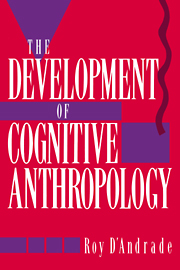Book contents
- Frontmatter
- Contents
- List of figures
- List of tables
- Preface
- 1 Background
- 2 Towards an analysis of meaning
- 3 The classic feature model
- 4 Extension of the feature model
- 5 Folk taxonomies
- 6 The growth of schema theory
- 7 Models and theories
- 8 Cultural representations and psychological processes
- 9 Cognitive processes and personality
- 10 Summing up
- References
- Name index
- General index
6 - The growth of schema theory
Published online by Cambridge University Press: 05 June 2012
- Frontmatter
- Contents
- List of figures
- List of tables
- Preface
- 1 Background
- 2 Towards an analysis of meaning
- 3 The classic feature model
- 4 Extension of the feature model
- 5 Folk taxonomies
- 6 The growth of schema theory
- 7 Models and theories
- 8 Cultural representations and psychological processes
- 9 Cognitive processes and personality
- 10 Summing up
- References
- Name index
- General index
Summary
The development of prototype theory and related ideas about basic level objects moved the focus of cognitive research from simple features to a more complex type of category structure. However, the trend towards greater complexity did not stop with the development of a theory of prototypes. In the mid-1970s it became apparent across the fields of linguistics, anthropology, psychology, and artificial intelligence that human cognition utilizes structures even more complex than prototypes. There was considerable variation in the names given for these more complex structures. “Frame,” “scene,” “scenario,” and “script” have all had some terminological currency. While this variability in labeling has not fully settled down, some consensus has developed on the use of the term schema.
George Mandler, a cognitive psychologist, describes a schema as a “bounded, distinct, and unitary representation.” He points out that the term goes back at least to Kant, who described the schema of a dog as a mental pattern that “can delineate the figure of a four-footed animal in a general manner, without limitation to any single determinate figure as experience, or any possible image that I can represent in concrete” (Kant, [1781] 1929).
Mandler describes schemas as “organizing experience.” He says:
activation of parts of a schema implies the activation of the whole, distinct from other structures and other schemas. Schemas are built up in the course of interaction with the environment. […]
- Type
- Chapter
- Information
- The Development of Cognitive Anthropology , pp. 122 - 149Publisher: Cambridge University PressPrint publication year: 1995
- 5
- Cited by



